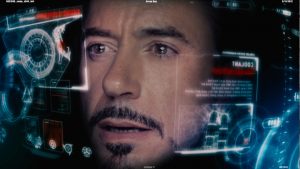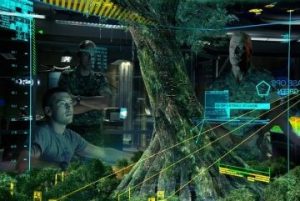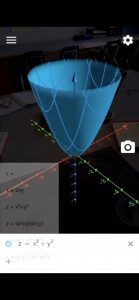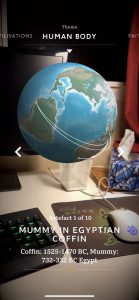Hello everyone, for this project, I would like to introduce Augmented Reality (AR) as a fast-developing technology that has the potential to transform education and change our life. This project will be presented as a blog. Let’s check it out!
- The introduction to AR and what calls for it
According to Wikipedia, Augmented Reality (AR) is an INTERACTIVE experience of a real-world environment where the objects that reside in the real world are enhanced by computer-generated multimodal information, primarily visual and auditory. Notice the keyword – interactive: the use of AR should be interwoven into our real-world experience to provide information that would enlighten us. Bearing this in mind as we will talk about it later. You might want to see an example at this point. In fact, the idea of applying AR in real life and facilitate daily works has long been seen in movies and games. Ideally, it would be delightful to do any jobs if we could have a system that interacts with us and informs us everything related to our circumstances. A famous example would be the movie, Iron Man.  The scene in which Tony Stark fought enemies in his suit with the immediate analyses and reports of his battleground presented in his helmet has impressed many. The information display in his helmet over the real world is a perfect example of AR. Other examples include Minority Report
The scene in which Tony Stark fought enemies in his suit with the immediate analyses and reports of his battleground presented in his helmet has impressed many. The information display in his helmet over the real world is a perfect example of AR. Other examples include Minority Report , Mission Impossible
, Mission Impossible , Avatar
, Avatar , and so forth. In these movies, we can witness how movie characters used AR devices to their advantage, and we know that it has the potential to change the world.
, and so forth. In these movies, we can witness how movie characters used AR devices to their advantage, and we know that it has the potential to change the world.
What makes AR possible now? As technology is developing faster than ever, high-resolution cameras and display, portable devices with huge RAM and processing speed, fast image processing, and fast wireless networks have made AR accessible in daily lives. There is also an increasing need that calls for AR, and a significant part of it is educational need. Ever since Gutenberg invented the printing press centuries ago, generations and generations have studied with books in schools. Don’t get me wrong – we still need to learn with books, but the fast-developing technologies have brought us many innovations, and even books are written, circulated, and read on electronic devices. Students are drawn by the novel experiences provided by electronic devices, and these devices are referred to as “distractions”. Apparently, many educators start to ask “Can we transform distractive devices into learning devices that provide novel and multimodal information? Students will love them!”. AR technology can definitely be the leap from textbooks to electricity-powered devices in the educational industry because what it does is to provide information based on the real world for people, and students may absorb such information as part of their learning.
- The existing educational AR apps
Using AR is simple: there are thousands of AR educational apps already existing and available for download in the Google Play Store or Apple Store. Therefore, anyone can enjoy AR with an iPhone or phone with an Android operating system. I’m sharing a few apps that I have tried here. My favorite is GeoGebra AR . The name probably originates from Geometry and Algebra. It is an educational app that specializes in math, obviously. It affords us to present algebraic geometry (including 3-D), which is extremely hard to graph by hands, onto the real world. The resultant graphs or shapes are manipulatable, and this feature makes it great for calculus classes. Of equal preference is BBC Civilisations AR, a British AR app that includes many historical artifacts across the globe. Virtual Earth
. The name probably originates from Geometry and Algebra. It is an educational app that specializes in math, obviously. It affords us to present algebraic geometry (including 3-D), which is extremely hard to graph by hands, onto the real world. The resultant graphs or shapes are manipulatable, and this feature makes it great for calculus classes. Of equal preference is BBC Civilisations AR, a British AR app that includes many historical artifacts across the globe. Virtual Earth is presented in front of us with all locations of the artifacts marked on it. We may explore their histories, marvel at their beauties, and even manipulate them! Imagine poking our heads into Egyptian coffin where mummy resides
is presented in front of us with all locations of the artifacts marked on it. We may explore their histories, marvel at their beauties, and even manipulate them! Imagine poking our heads into Egyptian coffin where mummy resides . This is impossible in the real world unless we are prestigious archaeologists. But this is made possible by this app and its AR technology. One last example is JigSpace, which is an app that shows us the working mechanism and the structure of many common objects, for instance, keys and locks
. This is impossible in the real world unless we are prestigious archaeologists. But this is made possible by this app and its AR technology. One last example is JigSpace, which is an app that shows us the working mechanism and the structure of many common objects, for instance, keys and locks . Once again, any object that we wish to explore can be presented in our perspective in a manipulatable way. The app will show us how the object works step-by-step by virtually breaking down the object. I’m firmly convinced that AR technology can make such explanations interesting, easy to understand, and hard to forget. Comparing these apps with AR technology with books, it becomes visible that AR technology has many benefits over traditional books, even when these apps are still very prototypical. The benefits include mobile learning – they are embedded in devices so they are easier to carry around than books, and we can’t carry books to meet unforeseen needs; better understanding – books are less efficient, when compared to AR apps, in explaining difficult and abstract ideas; engagement and interest – students will be more attracted by AR apps than textbooks; safe, resources-saving, and environment-friendly – AR apps provide risk-free hands-on learning without costing any material (imagine learning how to defuse a bomb or conduct a surgery using AR); and finally, inexpensive devices – all we need is a smartphone. Thus, we can see that AR technology transcends books and has the potential to bring text technology forward to the next level.
. Once again, any object that we wish to explore can be presented in our perspective in a manipulatable way. The app will show us how the object works step-by-step by virtually breaking down the object. I’m firmly convinced that AR technology can make such explanations interesting, easy to understand, and hard to forget. Comparing these apps with AR technology with books, it becomes visible that AR technology has many benefits over traditional books, even when these apps are still very prototypical. The benefits include mobile learning – they are embedded in devices so they are easier to carry around than books, and we can’t carry books to meet unforeseen needs; better understanding – books are less efficient, when compared to AR apps, in explaining difficult and abstract ideas; engagement and interest – students will be more attracted by AR apps than textbooks; safe, resources-saving, and environment-friendly – AR apps provide risk-free hands-on learning without costing any material (imagine learning how to defuse a bomb or conduct a surgery using AR); and finally, inexpensive devices – all we need is a smartphone. Thus, we can see that AR technology transcends books and has the potential to bring text technology forward to the next level.
Or… Can we? If you found that these apps are vastly different from the ones we see in movies, then you have found something valuable. Remember the definition of AR at the beginning? It is an interactive experience based on the real world. The biggest problem with the current AR technology is that all those apps, although quite useful and informative, are not interwoven into our real world. Rather, they simply ask us to find a bright surface so that they can present whatever information THEY have onto our world, but this has nothing to do with the information WE are encountering in our world. And this why they look very different from AR technology in movies because those examples in movies truly interact with reality and provide useful information for movie characters to utilize. So, there is still a huge gap between our expectations and reality. In addition, there are other limitations if we want to put current AR technology into education now. Technophobia is the top concern as technophobic teachers, which are the majority, refuse to try new technologies. The rigidity and stagnancy of the education system also add to the predicament. AR technology cannot be applied in classrooms without a degree of educational reform – schools have to design AR-specialized curricula, and teachers have to make AR-centered lesson plans. Therefore, it is virtually impossible for publicly funded schools to adopt AR technology in recent years. Last but not least, AR equipment, i.e. smartphones, can be a problem for poor regions. AR devices also require a fast wireless Internet connection, which is not always readily accessible.
- How will AR transform literacy and education in the future?
Despite its current limitations, AR still has the potential to transcend textbooks, transform literacy and classroom practices. In the future, AR will allow students to learn based on their environments with the best teachers anywhere and anytime. For example, if anyone has questions in his/her real life, perhaps asking what an object or idea is or how an object or theory works, he/she can ask AR to present the information onto his/her information overlay provided by AR devices. AR can also enhance teaching greatly: the teacher can project anything onto the students’ vantage point and explain accordingly. Not only the book can be replaced with visual-auditory texts, but the search engine may also be replaced as well because AR can present multimodal information on any real-world or abstract ideas immediately when requested. If we encounter any problem in our life, AR technology can guide us to solve or fix it. System crash, vehicle breakdown, electronics not working… anything can be fixed with AR-enabled guidance. With regard to school curricula, every student may receive curricular information and class instructions at any place in the world asynchronously. It will be an enhanced version of online learning. Learning materials and instructions can be pre-made and presented to each student at their own pace. Therefore, everyone can be a learner or a teacher at any time. The physical presence and face-to-face communication are no longer necessary for learning. These imaginations, once become reality, will accommodate the needs of many people and receive a tremendous amount of popularity.
To reach this utopia, AR has a long way to go. There are still many technical challenges it needs to address in the future. Among others, the biggest challenge, also the hottest scientific trend in the world now is artificial intelligence (AI). AI is especially important in AR as it allows users to verbally instruct AR to meet their needs. AI is also integral to object identification, without which AR is hardly interactive with the real world. AI is an algorithm that can learn by itself, and thus being self-improving in recognizing objects, so that AR technology can overlay information on the correct items in the world. The employment of AI also requires a higher amount of calculation, so AR needs either processing chips that are fast enough to process the calculation or wireless Internet connections that are fast enough to send the camera views to a centralized data analysis center for processing and receive the results. This could mean 5G and higher wireless Internet connection.
That’s it! If AR could overcome both technical and social obstacles, then it will become prevalent and transform text technologies, educational practices, and reading/writing spaces in the future.